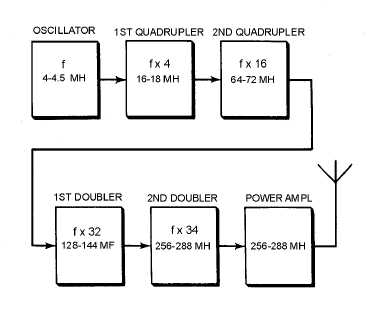1-36
HF AND VHF TRANSMITTERS.—Oscillators are too unstable for direct frequency control in
very- and ultra-high frequency transmitters. Therefore, these transmitters have oscillators operating at
comparatively low frequencies, sometimes as low as 1/100 of the output frequency. The oscillator
frequency is raised to the required output frequency by passing it through one or more FREQUENCY
MULTIPLIERS. Frequency multipliers are special rf power amplifiers which multiply the input
frequency. In practice, the MULTIPLICATION FACTOR (number of times the input frequency is
multiplied) is seldom larger than five in any one stage. The block diagram of a typical VHF transmitter,
designed for continuous tuning between 256 and 288 megahertz, is shown in figure 1-31.
Figure 1-31.—Block diagram of a vhf transmitter.
The stages which multiply the frequency by two are DOUBLERS; those which multiply by four are
QUADRUPLERS. The oscillator is tunable from 4 to 4.5 megahertz. The multiplier stages increase the
frequency by multiplying successively by 4, 4, 2, and 2, for a total factor of 64. In high-power, high-
frequency transmitters, one or more intermediate amplifiers may be used between the last frequency
multiplier and the power amplifier.
Q-23. Name a disadvantage of a single-stage cw transmitter.
Q-24. What is the purpose of the power-amplifier stage in a master oscillator power amplifier cw
transmitter?
Q-25. What is the purpose of frequency-multiplier stages in a VHF transmitter?
AMPLITUDE MODULATION
The telegraph and radiotelegraph improved man's ability to communicate by allowing speedy
passage of information between two distant points. However, it failed to satisfy one of man's other
communications needs; that is, the ability to hear and be heard, by voice, at a great distance. In an effort
to improve on the telegraph, Alexander Graham Bell developed the principles on which modern
communications are built. He developed the modulation of an electric current by complex waveforms, the
demodulation of the resulting wave, and recovery of the original waveform. This section will examine the
process of varying an electric current in amplitude at an audio frequency.

